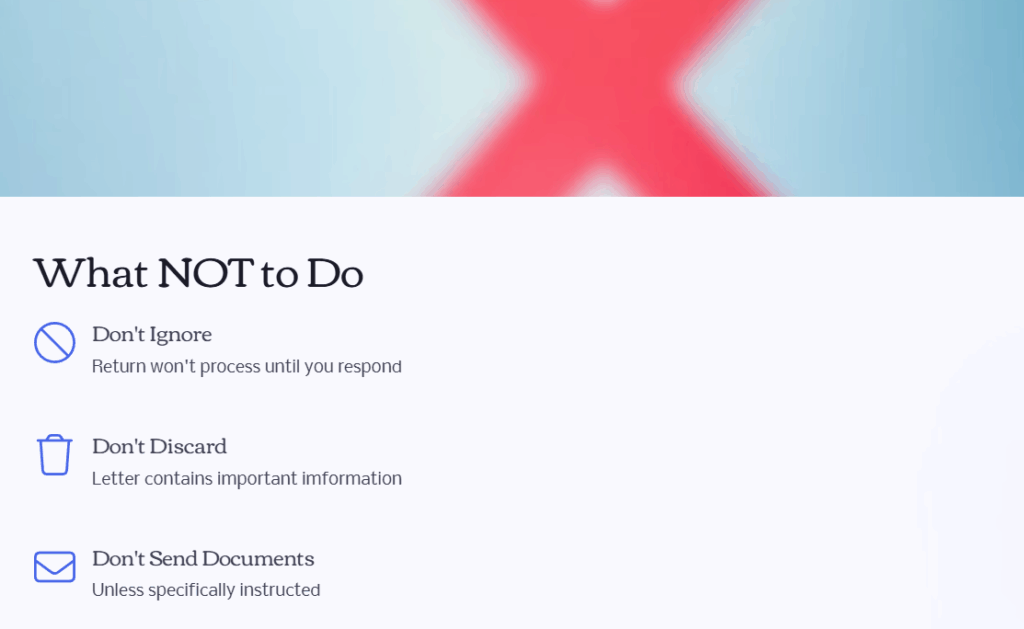If you received a letter from the IRS asking you to verify your identity, don’t panic — but don’t ignore it either.
Identity verification is a standard security measure the IRS uses to prevent tax refund fraud. Completing the process quickly ensures your tax return can be processed and your refund issued without further delays.
In this guide, we’ll explain:
- Why you received the notice
- What the IRS wants from you
- How to complete the verification
- What to expect after verifying
Explore more in this After-Filing IRS Series →
After You File: IRS Refunds, Notices, and Audits (Coming Soon)
├─ IRS Refund Tracker Guide, Avoid Delays
├─ Why Is Your Tax Refund Delayed
├─ Direct Deposit vs Paper Check: Which Is Faster
├─ Tax Refund Smaller Than Expected?
├─ How to Respond to an IRS Letter or Tax Notice
├─ ✅ IRS Identity Verification Guide: IRS Identity Theft Victim? (You are here)
├─ Got a CP2000 Notice From the IRS? What It Means and Exactly How to Handle It
├─ Disagree with an IRS Notice? How to Appeal with Sample
└─ What Triggers an IRS Audit? 7 Common Red Flags
Why Did I Get an Identity Verification Letter?
If the IRS sees something unusual or inconsistent on your return, it might flag your return for verification. This is especially common if:
- Someone else tried to file using your Social Security number
- You changed your address or filing status
- You claimed new dependents or large credits (like CTC or EITC)
- There are suspicious income patterns
🧾 Common Identity Verification Letters:
| Letter | Purpose |
|---|---|
| Letter 5071C | Online identity verification for e-filed returns Potential Identity Theft with Online Option |
| Letter 4883C | Phone verification for paper returns or certain errors Potential Identity Theft |
| Letter 5747C | In-person verification at a Taxpayer Assistance Center Potential Identity Theft In Person Appointment |
| Letter 5447C | Potential Identity Theft Outside the U.S. |
📌 Important: These are not audits — just identity confirmation.

✅ What You’ll Need to Verify Your Identity
Before you start, gather the following:
- The IRS letter you received
- Your most recent tax return (e.g., 2023 return for 2024 filing)
- Your prior year’s tax return (recommended)
- All income documents: W-2s, 1099s, etc.
- Your Social Security number or ITIN
- A mobile phone or computer with internet (for online ID verification)
- (Optional) Photo ID, such as a driver’s license or passport
How to Complete IRS Identity Verification
📍 Option 1: Verify Online (Fastest)
Best for Letter 5071C
- Visit the IRS Identity Verification Page
- Click “Verify your identity now”
- Sign in with ID.me or create an account
- Answer identity questions and upload documents if requested
- Submit and wait for IRS confirmation
📌 If successful, your return will continue processing and your refund will follow in a few weeks.
☎️ Option 2: Call the IRS (For 4883C Letter)
If your letter says to call the IRS (usually 4883C), follow these steps:
- Call the number on your letter as soon as possible
- Be ready to verify your identity by answering security questions
- Have your tax returns and documents nearby during the call
💡 Expect long hold times, especially during tax season.
🏢 Option 3: In-Person Verification (For 5747C Letter)
If instructed to verify your identity in person:
- Call the number on your notice to schedule an appointment at a local Taxpayer Assistance Center
- Bring your IRS letter, photo ID, and original tax return documents
- A representative will walk you through the process
This is rare but required in some high-risk fraud cases.
What Happens After Verification?
Once you complete verification:
- The IRS resumes processing your return (if no other issues)
- If everything checks out, your refund is issued in 2–3 weeks
- If problems remain, the IRS may request more information
What NOT to Do
- ❌ Don’t ignore the letter — your return won’t be processed until you respond
- ❌ Don’t throw away the notice — it contains important information
- ❌ Don’t send documents unless specifically instructed by the IRS

Is This a Scam?
Always be cautious. Real IRS letters:
- Arrive by U.S. Mail (not email or text)
- Contain specific contact information and instructions
- Never ask for full Social Security Numbers over the phone
Still unsure? You can verify your notice by visiting IRS.gov and checking the Notice Lookup Tool.
Getting an IRS identity verification letter can feel stressful, but it’s usually routine and fixable. The key is to act fast, follow instructions, and keep your documentation ready.
Verifying your identity early = faster refund, less hassle.
🔗 Want to see how all of this fits together?


